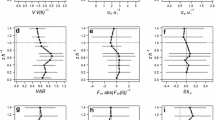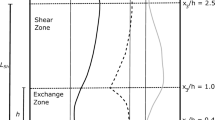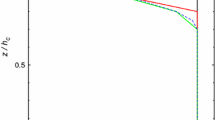Abstract
We examine the space–time structure of the wind and temperature fields, as well as that of the resulting spatial temperature gradients and horizontal advection of sensible heat, in the sub-canopy of a forest with a dense overstorey in moderately complex terrain. Data were collected from a sensor network consisting of ten stations and subject to orthogonal decomposition using the multiresolution basis set and stochastic analyses including two-point correlations, dimensional structure functions, and various other bulk measures for space and time variability. Despite some similarities, fundamental differences were found in the space–time structure of the motions dominating the variability of the sub-canopy wind and temperature fields. The dominating motions occupy similar spatial, but different temporal, scales. A conceptual space–time diagram was constructed based on the stochastic analysis that includes the important end members of the spatial and temporal scales of the observed motions of both variables. Short-lived and small-scale motions govern the variability of the wind, while the diurnal temperature oscillation driven by the surface radiative transfer is the main determinant of the variability in the temperature signal, which occupies much larger time scales. This scale mismatch renders Taylor’s hypothesis for sub-canopy flow invalid and aggravates the computation of meaningful estimates of horizontal advective fluxes without dense spatial information. It may further explain the ambiguous and inconclusive results reported in numerous energy and mass balance and advection studies evaluating the hypothesis that accounting for budget components other than the change in storage term and the vertical turbulent flux improves the budget closure when turbulent diffusion is suppressed in plant canopies. Estimates of spatial temperature gradients and advective fluxes were sensitive to the network geometry and the spatial interpolation method. The assumption of linear spatial temperature gradients was not supported by the results, and leads to increased spatial and temporal variability of inferred spatial gradients and advection estimates. A method is proposed to estimate the appropriate minimum network size of wind and temperature sensors suitable for an evaluation of energy and mass balances by reducing spatial and temporal variability of the spatially sampled signals, which was estimated to be on the order of 200 m at the study site.
Similar content being viewed by others
References
Anderson SP, Baumgartner MF (1998) Radiative heating errors in naturally ventilated air temperature measurements made from buoys. J Atmos Ocean Technol 15(1): 157–173
Anfossi D, Oettl D, Degrazia G, Goulart A (2005) An analysis of sonic anemometer observations in low wind speed conditions. Boundary-Layer Meteorol 114(1): 179–203
Aubinet M (2008) Eddy covariance CO2 flux measurements in nocturnal conditions: an analysis of the problem. Ecol Appl 18(6): 1368–1378
Aubinet M, Heinesch B, Yernaux M (2003) Horizontal and vertical CO2 advection in a sloping forest. Boundary-Layer Meteorol 108(3): 397–417
Aubinet M, Berbigier P, Bernhofer CH, Cescatti A, Feigenwinter C, Granier A, Grunwald TH, Havrankova K, Heinesch B, Longdoz B, Marcolla B, Montagnani L, Sedlak P (2005) Comparing CO2 storage and advection conditions at night at different carboeuroflux sites. Boundary-Layer Meteorol 116(1): 63–94
Aubinet M, Feigenwinter C, Heinesch B, Bernhofer C, Canepa E, Lindroth A, Montagnani L, Rebmann C, Sedlak P, van Gorsel E (2010) Direct advection measurements do not help to solve the night-time CO2 closure problem: evidence from three different forests. Agric For Meteorol 150(5): 655–664
Bohrer G, Katul GG, Walko RL, Avissar R (2009) Exploring the effects of microscale structural heterogeneity of forest canopies using large-eddy simulations. Boundary-Layer Meteorol 132(3): 351–382
Feigenwinter C, Bernhofer C, Vogt R (2004) The influence of advection on the short term CO2-budget in and above a forest canopy. Boundary-Layer Meteorol 113(2): 201–224
Garratt JR (1980) Surface influence upon vertical profiles in the atmospheric near-surface layer. Q J R Meteorol Soc 106: 803–819
Garratt JR (1992) The atmospheric boundary layer. Cambridge University Press, UK, p 316 pp
Hanna SR (1986) Spectra of concentration fluctuations—the two time scales of a meandering plume. Atmos Environ 20(6): 1131–1137
Heinesch B, Yernaux M, Aubinet M (2007) Some methodological questions concerning advection measurements: a case study. Boundary-Layer Meteorol 122(2): 457–478
Heinesch B, Yernaux Y, Aubinet M (2008) Dependence of CO2 advection patterns on wind direction on a gentle forested slope. Biogeoscience 5(3): 657–668
Howell JF, Mahrt L (1997) Multiresolution flux decomposition. Boundary-Layer Meteorol 83: 117–137
Lee XH, Hu XZ (2002) Forest-air fluxes of carbon, water and energy over non-flat terrain. Boundary-Layer Meteorol 103(2): 277–301
Leuning R, Zegelin SJ, Jones K, Keith H, Hughes D (2008) Measurement of horizontal and vertical advectlion of CO2 within a forest canopy. Agric For Meteorol 148(11): 1777–1797
Mahrt L (2008) Mesoscale wind direction shifts in the stable boundary-layer. Tellus A 60(4): 700–705
Mahrt L (2009) Characteristics of submeso winds in the stable boundary layer. Boundary-Layer Meteorol 130(1): 1–14
Mahrt L, Thomas C, Prueger J (2009) Space-time structure of mesoscale modes in the stable boundary layer. Q J Roy Meteorol Soc 135: 67–75
Mauder M, Desjardins RL, Gao Z, Van Haarlem R (2008) Errors of naturally ventilated air temperature measurements in a spatial observation network. J Atmos Ocean Technol 25(11): 2145–2151
Moderow U, Feigenwinter C, Bernhofer C (2007) Estimating the components of the sensible heat budget of a tall forest canopy in complex terrain. Boundary-Layer Meteorol 123(1): 99–120
Nakamura R, Mahrt L (2005) Air temperature measurement errors in naturally ventilated radiation shields. J Atmos Ocean Technol 22(7): 1046–1058
Novak M, Warland J, Orchansky A, Kettler R, Green S (2000) Wind tunnel and field measurements of turbulent flow in forests. Part I: Uniformly thinned stands. Boundary-Layer Meteorol 95: 457–495
Paw U KT, Baldocchi DD, Meyers TP, Wilson KB (2000) Correction of eddy-covariance measurements incorporating both advective effects and density fluxes. Boundary-Layer Meteorol 97(3): 487–511
Poggi D, Porporato A, Ridolfi L, Albertson JD, Katul GG (2004) The effect of vegetation density on canopy sub-layer turbulence. Boundary-Layer Meteorol 111: 565–587
Raupach MR, Thom A (1981) Turbulence in and above plant canopies. Annu Rev Fluid Mech 13: 97–129
Staebler RM, Fitzjarrald DR (2004) Observing subcanopy CO2 advection. Agric For Meteorol 122(3–4): 139–156
Staebler RM, Fitzjarrald DR (2005) Measuring canopy structure and the kinematics of subcanopy flows in two forests. J Appl Meteorol 44(8): 1161–1179
Thomas C, Foken T (2007) Flux contribution of coherent structures and its implications for the exchange of energy and matter in a tall spruce canopy. Boundary-Layer Meteorol 123: 317–337
Thomas C, Mayer JC, Meixner F, Foken T (2006) Analysis of low-frequency turbulence above tall vegetation using a Doppler sodar. Boundary-Layer Meteorol 119: 563–587
Thomas C, Martin JG, Goeckede M, Siqueira MB, Foken T, Law BE, Loescher HW, Katul G (2008) Estimating daytime subcanopy respiration from conditional sampling methods applied to multi-scalar high frequency turbulence time series. Agric For Meteorol 148(8–9): 1210–1229
Vickers D, Mahrt L (2006) Contrasting mean vertical motion from tilt correction methods and mass continuity. Agric For Meteorol 138: 93–103
Whiteman CD, Hubbe JM, Shaw WJ (2000) Evaluation of an inexpensive temperature datalogger for meteorological applications. J Atmos Ocean Technol 17(1): 77–81
Wilson KB, Baldocchi DD (2000) Seasonal and interannual variability of energy fluxes over a broadleaved temperate deciduous forest in North America. Agric For Meteorol 100(1): 1–18
Wilson KB, Meyers TP (2001) The spatial variability of energy and carbon dioxide fluxes at the floor of a deciduous forest. Boundary-Layer Meteorol 98(3): 443–473
Author information
Authors and Affiliations
Corresponding author
Rights and permissions
About this article
Cite this article
Thomas, C.K. Variability of Sub-Canopy Flow, Temperature, and Horizontal Advection in Moderately Complex Terrain. Boundary-Layer Meteorol 139, 61–81 (2011). https://doi.org/10.1007/s10546-010-9578-9
Received:
Accepted:
Published:
Issue Date:
DOI: https://doi.org/10.1007/s10546-010-9578-9




